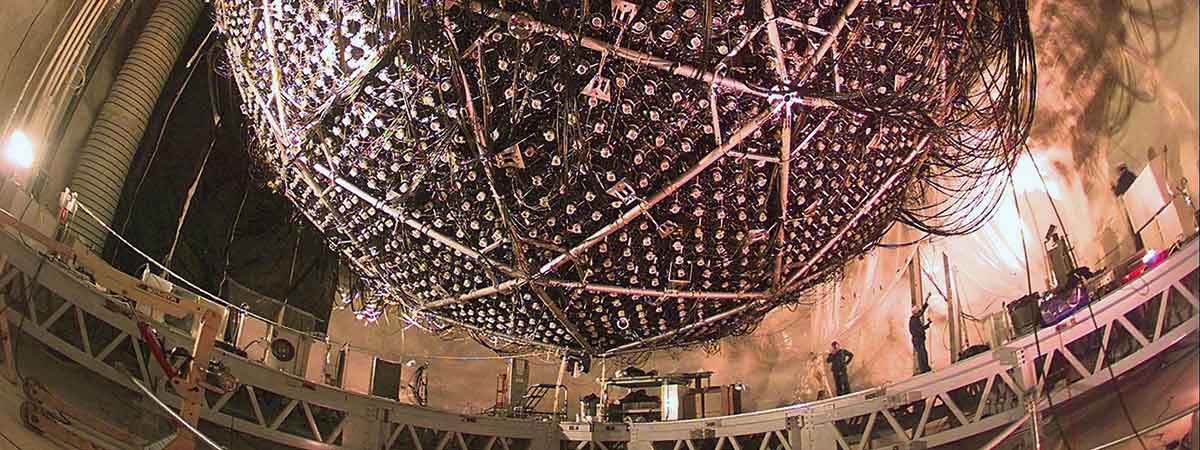2,100 metres below the Earth's surface, the physicists of SNOLAB are searching for the tiny and elusive building blocks of the universe: neutrinos.
Neutrinos are electrically neutral elementary particles, which hurtle through space practically at the speed of light. Since they have no electrical charge, they barely interact with matter and can thus pass through it virtually unhindered. This allows them to cover great distances and travel to Earth from the most remote galaxies. Due to their elusive nature, however, they are particularly difficult to research.
Detection with light flashes
To catch these minuscule elementary particles, researchers have moved underground. The SNOLAB physics laboratory is located in a nickel mine in the Canadian city of Sudbury (Ontario). Here, the scientists have access to a cleanroom area measuring 5,000 square metres, while a 2,100 metre layer of rock protects the lab against cosmic radiation – only neutrinos can penetrate this shield. At the heart of the facility is the neutrino detector, which consists of a spherical acrylic tank with a diameter of 12 metres.
For the experiments, which are currently conducted under the name SNO+, this tank is filled with 800 metric tons of a special liquid, made up of the hydrocarbon linear alkylbenzene (LAB). This liquid emits UV rays when agitated by ionizing radiation. The UV light in turn stimulates a colorant dissolved in the liquid, which then fluoresces blue. When passing through the liquid, any neutrinos that come close enough to its atomic nuclei to trigger an interaction will thus generate small flashes of light. These are detected by highly sensitive sensors that surround the tank.
To ensure that the subatomic particles are detected successfully, all undesirable substances must be removed from the LAB. This is done using vacuum technology. With the aid of vacuum pumps, a negative pressure of 20 millibar is generated in the cleaning system. At a temperature of 238 degrees, even the tiniest traces of heavy metals are removed from the liquid in a multi-stage distillation process. Water vapour and nitrogen are then passed through the liquid in a so-called stripper column, again under vacuum. This expels the gases radon, krypton, argon and oxygen and regulates the water content of the liquid. Condensers positioned at the air outlets of the vacuum pumps ensure reliable recovery of the vapours. Here, the exhaust gases from the cleaning process are cooled, liquefied and filled into collecting vessels.
Nobel Prize for neutrino research
In the new SNO+ experiments, the LAB replaces the heavy water with which the tank was filled during the original SNO project. For these first investigations, the head of the SNO experiment, Arthur McDonald, was awarded the Nobel Prize for physics in 2015. From 1999 to 2006, he used this heavy water to research neutrinos produced in the sun through nuclear fusion. However, the results did not match the predictions of the standard model of physics, which had previously assumed neutrinos to be massless.
Instead, the discovered deviations were explained with the alternative theory of neutrino oscillation: The three different types of neutrinos (electron, muon and tau neutrinos) are able to transform into one another. However, this is only possible if they have a mass, no matter how small it may be.
Compared to the original experiment with heavy water, the interaction of neutrinos with the LAB emits a significant amount of light. The main aim of the new investigations is to research the contentious process of neutrino-less double beta decay, while the liquid LAB can also be used to examine proton-electron-proton (PEP) solar neutrinos. Other objectives include the detection of geo-neutrinos from radioactive decay processes in the Earth as well as of reactor neutrinos from nuclear fission reactions. It would also be possible to detect supernova neutrinos, if a supernova should occur in our galaxy. With their neutrino measurements, the researchers hope to gain further insight into the fundamental forces of the universe.
Since 2012, Snolab has been using vacuum technology from Busch.
